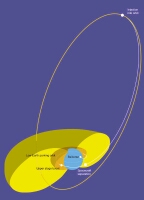Orbit/Navigation
INTEGRAL (with a total launch mass of about 4000 kg) was launched on October 17th 2002. It was placed into a geosynchronous highly eccentric orbit with high perigee in order to provide long periods of uninterrupted observation with nearly constant background and away from trapped radiation (electron and proton radiation belts).
INTEGRAL was launched by a Russian PROTON launcher from Baikonur/Kazakstan.
 |
- 72-hour orbit
- inclination of 51.6 degrees,
- perigee of 9000 km
- apogee of 153 000 km
Owing to background radiation effects in the high-energy detectors, scientific observations will be carried out while the satellite is above a nominal altitude of 40 000 km. This means, that ~90 % of the time spent in the orbit provided by the Proton launcher can be used for (real-time, 131.1 kbit/s) scientific observations. An on-board particle radiation monitor allows to assess the radiation environment local to the spacecraft. In case of low background environment, observations below 40 000 km altitude should be possible.

